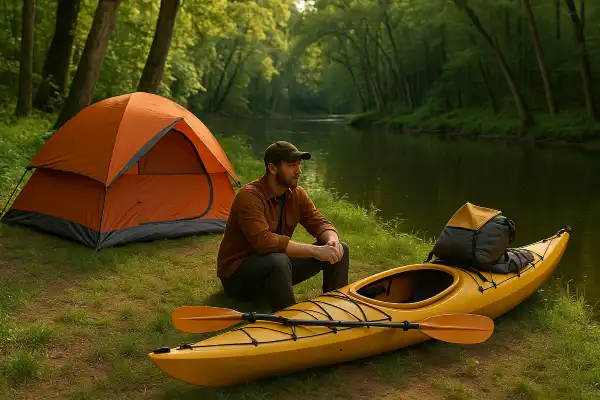Where can you kayak camp in Virginia is a question I hear constantly from paddlers seeking that perfect blend of adventure and solitude. Virginia’s diverse waterways offer some of the most rewarding paddle-in camping experiences on the East Coast, yet many outdoor enthusiasts never discover these hidden gems.
During my early years guiding trips throughout the Commonwealth, I learned that Virginia’s geography creates a unique advantage for kayak campers. From the tidal waters of the Chesapeake Bay to the ancient New River, each waterway tells its own story and offers distinct camping opportunities that range from beginner-friendly to wilderness challenges.
Where can you kayak camp in Virginia?
Virginia offers exceptional kayak camping opportunities across diverse waterways, from coastal barrier islands to mountain rivers. The Commonwealth features multiple state parks with designated paddle-in campsites, allowing kayakers to access remote wilderness areas only reachable by water.

Northern Neck and tidal waters
Belle Isle State Park stands out as Virginia’s premier kayak camping destination. Located on the Rappahannock River in Lancaster County, Belle Isle offers the Brewers Point Hike-in or Paddle-In Primitive Tent Campground, which is not accessible by vehicle. You’ll paddle approximately 2.5 miles around the park’s riverfront to reach the primitive sites at the tip of Brewer’s Point, where you can unload your boat, make camp, and enjoy waterfront solitude.
The four designated sites at Brewer’s Point each feature basic amenities including picnic tables, fire rings, and lantern posts. The park rents canoes specifically for this paddle-in camping experience, making it accessible even if you don’t own a kayak. The shallow, protected waters of Deep Creek and Mulberry Creek provide ideal conditions for beginners while still offering the authentic wilderness experience that draws seasoned paddlers.
Caledon State Park presents a more challenging option for experienced kayakers. Six primitive campsites welcome campers with stunning water views year-round along the shores of the Potomac River. However, this adventure requires serious planning. Paddling to Caledon State Park should only be attempted by very experienced paddlers as the closest launching point is at Aquia Landing Park which is 12 miles upriver, while downriver, the closest place to launch is at Colonial Beach which is nearly 20 miles from the park.
Westmoreland State Park offers a group paddle-in campsite that recently opened in 2017. This option works well for organized groups seeking a shared wilderness experience along the Potomac River’s fossil-rich shoreline.
Mountain and river systems
New River Trail State Park provides one of Virginia’s most unique kayak camping experiences at Baker Island. Part of New River Trail State Park, you reserve a site on Baker Island, then paddle your own kayak or canoe a short distance from the state park boat ramp to pitch your tent on primitive Baker Island. Seven designated tent sites are available, each with a tent pad and fire ring, accessed via the canoe/kayak landing on the south side of Baker Island.
Reservations are strongly encouraged because prior registration of a site on Baker Island is required, even for walk-ins. The New River’s gentle current and clear waters create perfect conditions for paddlers of all skill levels. Two pit toilets stand on the island, but campers must bring their own water.
James River State Park offers accessible river camping through its Canoe Landing campground. James River State Park offers six camping areas, one of which hosts ten primitive tent sites with water views and river access via canoe launch. This location provides the convenience of drive-up access combined with immediate river launch capabilities, perfect for weekend warriors who want the camping experience without an extensive paddle.
Coastal wilderness
False Cape State Park delivers Virginia’s most remote and challenging kayak camping experience. Camping is permitted year-round and campsites at the park are in four distinct areas – Barbour Hill Bay, Barbour Hill Ocean, False Cape Landing Bay and False Cape Landing Ocean – which are separated by significant distances. There’s no vehicular access to this park.
You can launch your kayak from Little Island City Park and paddle to the False Cape Landing boat dock, a perfect tie-up for kayaks. The camping areas accommodate primitive camping, tents only and offer 12 sites. Drinking water is available in three locations, all in the Barbour Hill section. Campers must park at Little Island City Park and display their confirmation letter on the dash to prevent their vehicle from being towed. Open fires are not permitted; camp stoves may be used for cooking.
Planning your Virginia kayak camping adventure
Reservations and permits: Twenty-nine state parks throughout the state offer camping with a total of more than 1,800 campsites, and reservations can be made through the Virginia State Parks system. Most paddle-in sites require advance reservations, especially during peak season from May through September.
Safety considerations: Virginia’s tidal waters demand respect for weather conditions and tide schedules. The American Canoe Association’s standard for safe paddling is that the sum of the air temperature and water temperature be greater than 120 degrees. Always check weather forecasts and water conditions before departing.
Essential gear: Beyond standard camping equipment, bring extra water containers since most paddle-in sites lack potable water. Personal floatation devices are available from parks’ rental stations, though bringing your own properly fitted PFD is always recommended. Pack everything in waterproof bags and follow Leave No Trace principles.
Best seasons: Spring and fall offer ideal conditions with comfortable temperatures and fewer bugs. Summer provides the warmest water but brings higher mosquito populations and thunderstorm risks. Winter camping is possible at some locations but requires cold-weather expertise.
Conclusion
In May, I guided a family to Belle Isle’s Brewer’s Point for their first kayak camping experience. Watching their 12-year-old daughter catch her first blue crab right from our campsite reminded me why these paddle-in adventures create such lasting memories. That evening, as we watched osprey fish in the golden light of sunset, the father mentioned how different this felt from their usual crowded campground experiences. Following a well-researched guide transforms an ordinary camping trip into an extraordinary wilderness adventure that connects families with Virginia’s pristine waterways in ways that simply aren’t possible from a car-accessible campsite.
